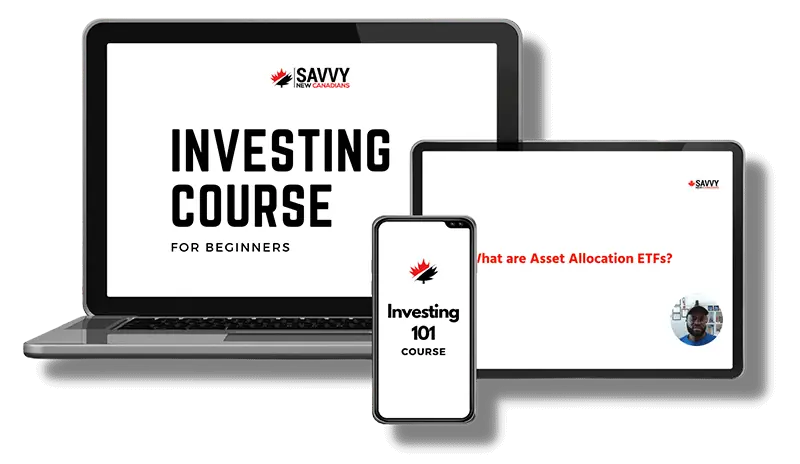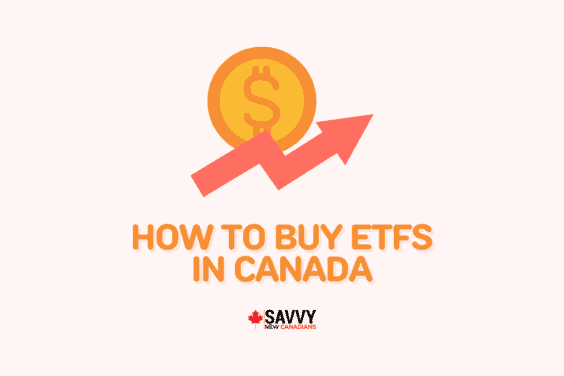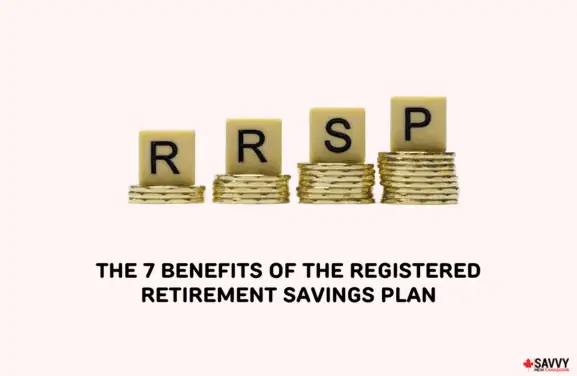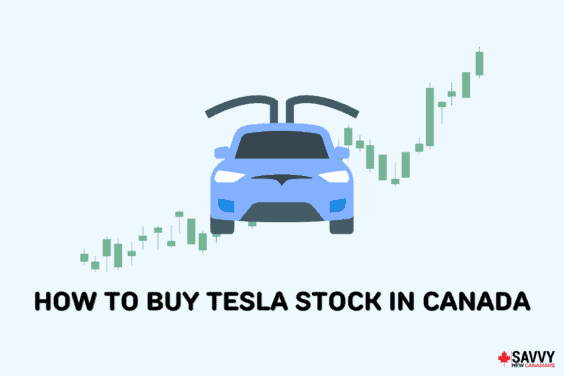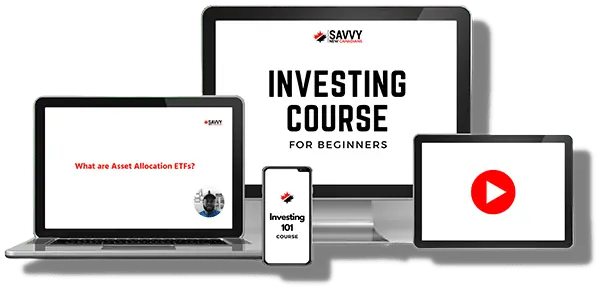If you had an extra $1,000, how would you invest it?
This article will discuss ten different ways to invest $1,000 in 2024 to start growing your money now.
10 Ways To Invest $1,000 Right Now in 2024
1. Pay Off Your Debt
Before investing, you will want to consider paying off any high-interest debt. This type of debt refers to things like credit card debt or personal loans and not mortgages.
Why should you pay off your debt? No matter how much you make from investing, your debt will diminish your gains, especially if it continues to compound. This is an easy way to make the most of a $1,000 windfall.
2. Build Up Your Emergency Fund
Do you or your family have an emergency fund? A general rule is to have between 3 to 6 months of either your salary or your expenses set aside in case of an emergency. You will want this fund to be as liquid as possible, so hold your emergency fund in cash, not assets.
What’s the best way to hold cash as an emergency fund? Putting your money into a High-Interest Savings Account can earn you a solid interest rate while your cash sits there and accumulates.
Note that putting your money into a HISA is safe as there is no chance of losing money. The interest rate in the HISA is determined by the Bank of Canada’s overnight interest rate, so it could be lower in the future.
The apparent downside to holding this much cash in your HISA is the opportunity cost of investing that money. While the capital gains from stocks might be more alluring, you will thank yourself when a sudden emergency cost arises.
3. Invest in Your RRSP or TFSA
Registered investment accounts in Canada have plenty of benefits for Canadian investors. They are tax-friendly and can be a great place to park $1,000 until your retirement.
With an RRSP, any contribution you make is tax-deductible. Investment income earned is not taxed until you withdraw your investments, hopefully in your retirement.
The TFSA, or Tax-Free Savings Account, has been popular since it launched in 2009. This account is entirely tax-free for withdrawals, capital gains, dividends, and interest. The caveat is that you can only contribute a set amount each year, with the current lifetime contribution at $95,000 as of 2024.
Both accounts offer the benefit of long-term compounding on your investments. You can choose from stocks, ETFs, mutual funds, GICs, bonds, and other assets to invest your $1,000 in.
4. Buy a GIC
A GIC or Guaranteed Investment Certificate is a popular fixed-income asset in Canada. With this investment, you would invest your $1,000 for a given term and earn interest until the term ends. At the end of that term, you will receive your initial $1,000 plus any interest earned.
As you might imagine, GICs are a very low-risk investment. They are popular in high-interest rate environments when equities are more volatile. The downside to GICs is a low return compared to other assets, and most of them require you to lock your money in for anywhere from 1 to 10 years.
5. Open a Non-Registered Investment Account
If you are financially savvy and have already contributed to your TFSA and RRSP, you could also invest this $1,000 into a new non-registered investment account. While these are not as tax-friendly as the registered accounts, they are just as suitable for growing your investments.
You can invest in any assets in a non-registered account as well as trade options and short stocks. The downside to these accounts is that any capital gains, dividends, or interest earned are taxable come income tax season. If you are considering opening a non-registered account, you should consider maxing out your contributions to your TFSA or RRSP first.
6. Invest in Stocks
The natural reaction to the question ‘How to invest $1,000 right now’ is to buy stocks with it. But what are stocks? When you buy stocks, you are buying a small piece of ownership in a publicly traded company. As the company’s business improves, so too does the price of the stock.
You can buy stocks in any registered or non-registered account in Canada. As far as assets go, stocks are one of the riskiest on this list due to the unpredictability and potential volatility of the equities market. There is the risk of massive losses if you invest in the wrong stocks.
On the bright side, stocks provide the best potential long-term reward and capital growth. Choose the right stocks, and that $1,000 could exponentially grow for the rest of your life. To buy stocks, you will need a brokerage account. Consider a low-cost discount brokerage like Questrade or Wealthsimple to save money on trading commissions.
7. Invest in ETFs
ETFs or Exchange-Traded Funds are like investing in a basket of stocks all in one asset. These funds typically track a sector or an index, providing you with instant exposure to a wide range of stocks or other assets.
For most Canadian investors, a portfolio of ETFs will provide enough diversification and stability. These ETFs will rise and fall in price but generally less violently than individual stocks. They also pay out dividends and are cheaper to own than buying all of the underlying stocks on their own.
The downside to ETFs is that they usually do not provide the same capital appreciation as individual stocks. They also come with MERs or Management Expense Ratios, which are basically fees for owning the fund charged by the ETF provider.
8. Invest in Bonds
If stocks or ETFs are too risky, you can consider investing in fixed-income assets like bonds. They are very much like GICs in that you invest your $1,000 for a term and receive back this investment plus any interest earned at the end of that term.
Bonds do have slightly more upside in that they can provide minimal capital appreciation. They can provide steady cash flow while hedging against any market or economic volatility. You can buy bonds in any registered or non-registered accounts in Canada.
9. Invest Using a Robo-Advisor
Most brokerages in Canada now offer a robo-advisor service for investors. Traditionally, robo-advisors are machine-driven, using algorithms to invest your money according to your financial plan. They are intended to take the human emotion out of creating a diversified portfolio.
Robo-advisors are great for investors who want to just contribute their money and have someone, or something, decide what to invest in. The downside is that robo-advisors tend to come with higher fees, which can eat into your long-term gains.
Some examples of robo-advisors in Canada include Wealthsimple Invest, Questwealth Portfolios, and Qtrade Guided Portfolios.
10. Save for a Home in an FHSA
The FHSA, or First Home Savings Account, was introduced earlier in 2023. This brand-new registered account allows Canadians to save money in a tax-friendly way to put towards their new home.
An FHSA allows you to invest in all assets available to other registered accounts. Any contributions are tax-deductible, and capital gains are not taxed if they are put towards purchasing your home.
There are some stipulations: the annual contribution limit is $8,000, and the lifetime contribution is $40,000. The FHSA can only be open for 15 years or until you turn 71. In a real estate market like Canada’s, every penny helps!
Use Compound Interest To Your Advantage
Some refer to compound interest as the eighth wonder of the world. Compound interest is the secret formula to how many people build their wealth over their lifetime.
What makes compound interest so great? You can think about it as earning interest on your interest, with the amount steadily rising over time. If you leave $1,000 in your account, each subsequent interest payment will be larger than the last. Here is a look at how fast your $1,000 would grow with a 5.0% interest rate each year.
| Original Amount Each Year | New Amount with Interest |
| $1,000 | $1,050 |
| $1,050 | $1,102.50 |
| $1,102.50 | $1,157.625 |
| $1,157.625 | $1,215.51 |
| $1,215.51 | $1,276.28 |
| $1,276.28 | $1,340.09 |
| $1,340.09 | $1,407.10 |
| $1,407.10 | $1,477.46 |
| $1,477.46 | $1,551.33 |
| $1,551.33 | $1,628.89 |
This is assuming no further deposits as well. In ten years, your $1,000 investment has already made an additional $628.89 or 63.0%.
Diversify Your Portfolio
This does not just mean investing in a bunch of different stocks. A truly diversified portfolio has asset diversification as well.
Consider diversifying your investment portfolio with some fixed-income assets like bonds or GICs to hedge against market volatility or downturn.
Understand Risk vs Return
What sort of return are you seeking, and how much are you willing to risk? With investing, everything comes down to your personal risk appetite.
If you do not want to lose any of that $1,000, then you will likely invest it in safer assets like GICs or bonds. If you are willing to risk more of your money to make a potentially higher return, you will be more attracted to individual stocks.
Understanding your own risk tolerance and the risk vs. return of each asset is a critical part of investing.
Conclusion
As you can see, there are plenty of ways to invest that $1,000. We listed ten ways to invest $1,000, but we didn’t even include other assets like real estate, alternative investments, or even cryptocurrencies like Bitcoin.
Where you decide to invest that $1,000 depends on your risk tolerance, investment goals, and investment horizon. There is a long list of options, but choose one that fits your own personal financial strategy.
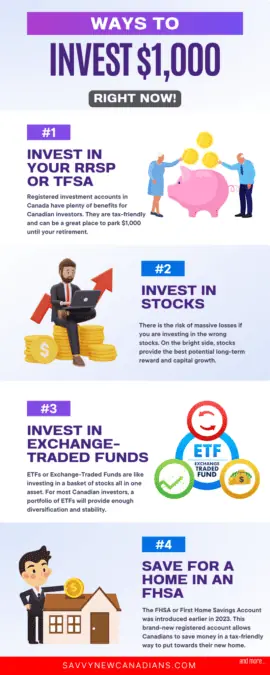
Related:
